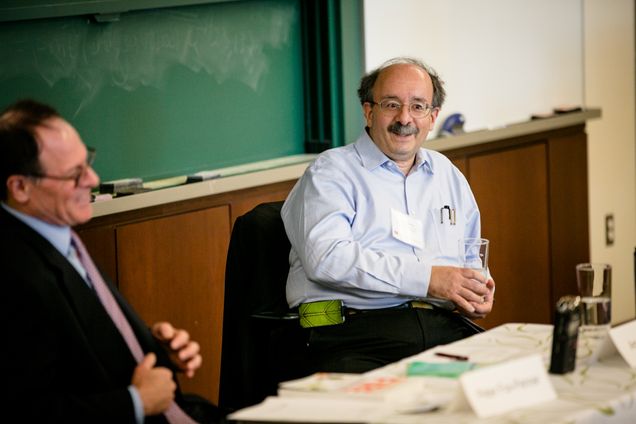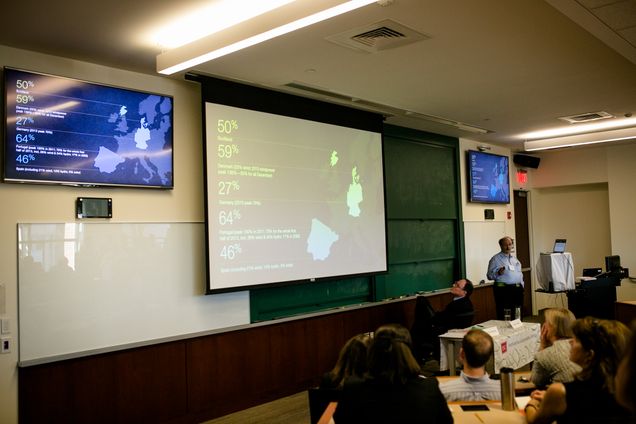“Disruptive Energy Futures”: Envisioning a low-carbon economy in 2050
By Jacquie Ashmore / September 23, 2016

I started work at the Institute for Sustainable Energy two weeks ago, and have been in a whirlwind of introductions to exciting projects and notable experts! Highlights include learning about the Institute’s work with the Green Ribbon Commission, identifying how to reduce the city’s emissions by 80% by 2050, and discussing practical ways for utilities to engage successfully in decarbonization of the electric grid.

A third highlight was hearing Amory Lovins of Rocky Mountain Institute present a bold vision of transformational changes that can dramatically reduce carbon emissions from transportation, buildings, and the electric grid in his public lecture with an audience of over 100 people at the Institute for Sustainable Energy at Boston University on September 15th. He focused especially on the potential of energy efficiency, integrative design, and new utility business models to feature in “Disruptive Energy Futures” that, according to his preliminary estimates, could maintain the global average temperature increase below 2 degrees Celsius.

Lovins outlined his analyses of the US economy, published in “Reinventing Fire” (Lovins and the Rocky Mountain Institute, 2011), which show that in 2050 the US economy could be run with no reliance on oil, coal, or nuclear energy and less natural gas, with projected savings of $5 trillion, an economic growth factor of 2.6, and reduction of carbon emissions of approximately 85%. He projects that this can be accomplished without changes in federal policy and without new technologies, relying instead on regional and state level policies and private sector drivers, as well as military innovation. Comparable consideration of the potential trajectory in China, recently published in “Reinventing Fire: China,” and Lovins’ extrapolations for the rest of the world support the estimates of limited global average temperature increases.
What are some of the specific pathways to accomplish this transformation by 2050?
As an example, Lovins described a scenario for transportation in which energy efficiency increases can enable increased mobility without reliance on oil by 2050. The adoption of electric cars made from carbon fiber, with significant weight reduction, as well as a projected tripling in fuel efficiency of trucks and airplanes, are important parts of the change. Changes in consumer behavior, moving away from vehicle ownership and towards multi-modal transportation, will also contribute to reduced emissions.
For buildings, Lovins spoke about the potential for integrative design to dramatically reduce their energy consumption in a variety of climates across the world. Notably, this is predicated on broadening deployment of technologies that are already established today and is not reliant on new building technologies.
Most significantly, Lovins emphasized the radical changes already underway in the electric grid. He spoke of the multitude of disruptors, including storage, regulatory shifts, and new financial and business models, and of the decrease in price and the increase in demand for distributed renewables. A case study illustrated how, in the future, accurate day-ahead forecasting of the intermittency of renewable energy sources can be used to manage the widely discussed reliability issue effectively.

Using numerous historical examples through the talk, Lovins highlighted the potential for unexpectedly rapid change in business and in markets. If we aggressively harness the potential of future opportunities for further increased energy efficiency, distributed renewables, and storage, implemented in a networked world using new models for energy management, we may limit the threat posed by climate change, nuclear proliferation, energy security and energy poverty. Lovins’ talk painted a thought-provoking picture of how good choices could drive large-scale and rapid changes to preserve our planet and strengthen the world economies.
Here at the Institute for Sustainable Energy, we’re hard at work on leveraging the expertise of Boston University faculty and staff – across business, policy, and technology – to advance and implement sustainable energy solutions with external partners. We’re deeply involved in work on transportation, buildings, and transformation of the electric grid, and we hope you will stay in touch with us to learn about our accomplishments as we take our work forward.
Jacqueline Ashmore is the Director of Research and Outreach Activities for Boston University’s Institute for Sustainable Energy. Her work in clean energy has focused on photovoltaics, including the development of novel solar systems that can be installed on residential rooftops at low cost. She previously worked at Fraunhofer Center for Sustainable Energy Systems and Union of Concerned Scientists. Jacquie has a PhD in Applied Mathematics from Harvard University.
The Institute for Sustainable Energy is a university wide research center dedicated to facilitating the transition to a sustainable, climate-safe global energy system. Through interdisciplinary research, policy analysis, and collaborative engagement, their mission is to ensure that the energy systems of the world provide abundant, sustainable, and universally accessible energy services to both emerging and advanced economies.